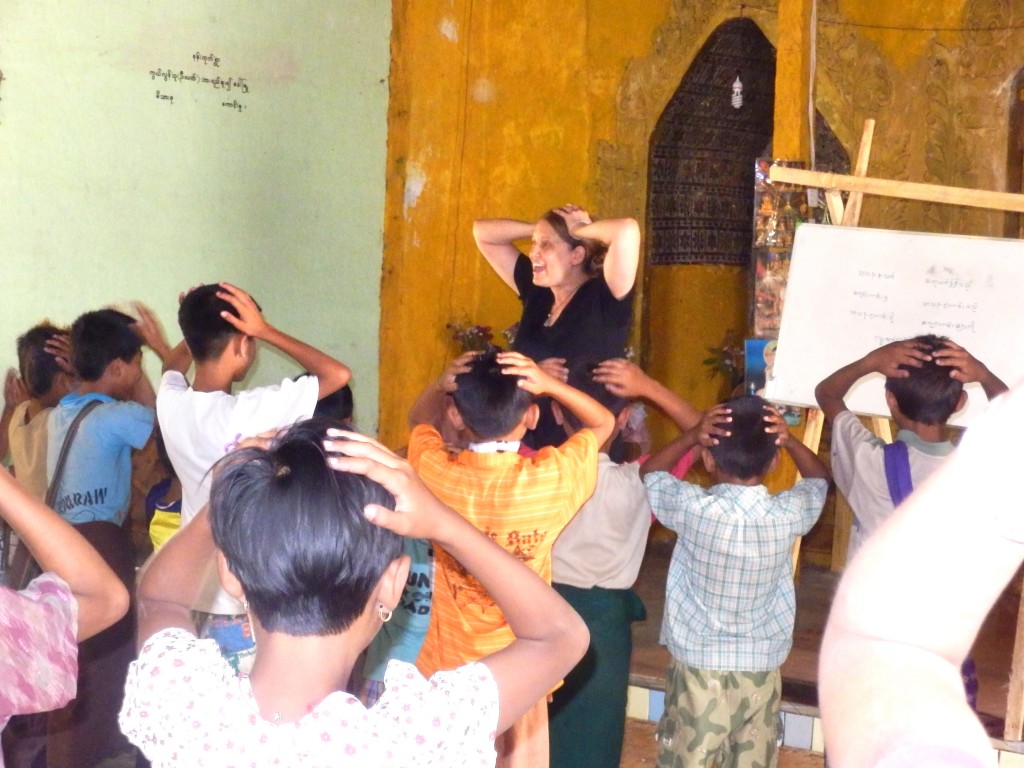Tell us about the project.
Its located on top of a hill, with beautiful views all around.
I loved to wake up early and watch the sun rise over the lake.

Learning names for parts of the body with “Head Shoulders Knees & Toes”
We also offered lessons to primary school kids (ages 6-12) from the nearby villages.
Classes were taught by grade level, and we had between 20 and 80 students in each group.
The Myanmar team members gave lessons on subjects like hygiene, environmental awareness, and democracy.

What were the facilities like?
What equipment did you have?
Because the monastery is so remote, they dont have electric facilities.

There is a generator that runs from 7:00 to 11:00 p.m., but no power during the day.
We brought some portable speakers with us, but they werent loud enough to use with such large groups.
That way we could play music, and show videos.
I had brought a few teaching supplies with me, but hadnt planned on such large classes.
That helped a lot.
Its amazing how creative you get when you dont have your classroom supplies to rely on!
Our living accommodations were simple, but comfortable.
The bathrooms were Asian style and outdoor showers.
What were lessons like?
The primary school students met for three hours each afternoon in a large, open air pavilion.
On average, about 60 students came each day.
There was a big difference between the ages and levels of the students.
But using music made it easy for all of the students to participate.
When working with a new group, I like to start lessons with a simple warm-up exercise.
I say a command, and they follow the directions.
Within a couple of minutes, we are all laughing and having fun.
They didnt know it, but I was getting them ready to sing our first song, Hello Hello!
from Super Simple Songs 3.
They were so excited that they could understand, it was a great confidence booster!
I followed a traditional lesson plan format from this article onTeaching 2 and 3-year olds.
We followed that with alphabet practice, story time and the goodbye song.
Of course, I had the Twinkle, Twinkle Little Star app with the video.
That was a huge hit!
We were able to cover a lot of material during our two weeks together.
How does using music help your teaching?
Music is my favorite teaching tool!
I love how music brings language to life.
When I put on a song, the kids and I just cant sit still.
We have to get up, dance, sing, and wave our arms around.
It makes the classroom a fun, and safe, place to be.
Kids feel confident, because they can participate at their own level.
Some just follow the gestures, others are singing and later speaking the lyrics.
Mistakes dont matter, we just keep going.
I love how much we use our imaginations.
Music takes us places that other teaching methods dont.
What was your favorite part of your trip to Myanmar?
Definitely working with the students.
They were so enthusiastic and committed to learning.
Even though it was a lot of work and long hours, I loved every minute of it.
Myanmar is a beautiful country and its going through a lot of changes right now.
Its very exciting to see the country opening up, I feel lucky to have visited there.
There are two more workcamps at the monastery this year, so I plan to go back.
Currently, they are putting together a library.
I love being in the classroom, and traveling.
This experience gave me the chance to do both.
Sara Wall is originally from the United States.
She currently resides in Thailand, where she splits her time between writing and working with students.
you’re able to read about her adventures atwww.travelsara.com.